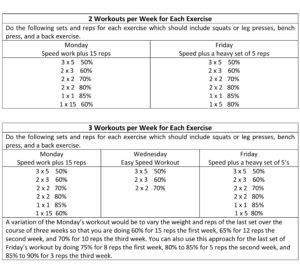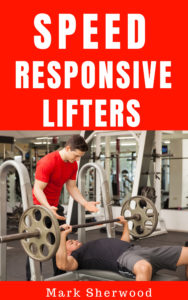Some lifters respond favorably to speed training and should make it a part of their workouts on a regular basis. Speed training simply means that you impart maximum force and speed into each rep. In order to do this, you must use weights that are light enough to lift with a fast rep speed. You must also be careful to avoid performing your sets in a manner that produces a high degree of fatigue because fatigue impairs your ability to impart maximum force and speed into your reps. You can reduce fatigue by using a weight that would normally allow 12 to 18 reps per set, but instead of doing a full set of 12 to 18 reps, you will do mini sets consisting of 1 to 5 reps per set. In order to accumulate enough volume to stimulate a training effect with a small number of reps per set, 8 to 12 sets must be performed. Once again, the key to speed training is to use relatively light weights and to perform each rep with as much speed as possible for only 1 to 5 reps per set.
Speed workouts are normally performed with basic compound exercises such as bench presses, squats, leg presses, deadlifts, and seated pulley rows or lat pulldowns. Most likely you will find it very awkward to perform speed work in conjunction with isolation exercises such as barbell curls, triceps extensions, dumbbell lateral raises, leg extensions, and leg curls. I wouldn’t recommend that you do speed work with the isolation exercises listed.
If you are wondering what a speed workout might look like, the following workouts will provide examples of how you might construct a speed workout:
A Speed Workout
Do three exercises consisting of squats, bench presses, and seated pulley rows. Impart maximum force and speed into each rep as you perform the following sets and reps for each exercise performed:
3 sets x 5 reps with 50% of your max
2 sets x 3 reps with 60%
2 sets x 2 reps with 70%
2 sets x 2 reps with 80%
1 set x 1 rep with 85%
Speed Work Plus Traditional Strength Training
If you do the workout listed two to three times per week for each lift, and you notice that it has a positive effect on your strength, you are a lifter who responds well to speed workouts. Most lifters will need to add other types of training to get the best overall effect from their workouts. In other words, you may be responsive to speed work, but it is likely that you will respond better if you combine speed work with sets that are performed in a more traditional manner. This can be done by doing a speed workout followed by a more traditional strength workout on a separate day. The more traditional workout may consist of doing each exercise for 3 sets of 5 reps, or 5 sets of 5 reps, or pyramiding up to a heavy set for 1 to 3 reps. Speed work can also be integrated with other types of traditional training within the same workout by doing speed sets followed by one to two full sets of 5 to 15 reps for each exercise. An example of this is shown in the following training schedules:
The only way to know whether you are a speed responsive lifter is to incorporate speed work in to your workouts on a regular basis. If you respond to it with an increase in strength, it would only make sense to make it a permanent part of your training. Best of training to you.
Resources


